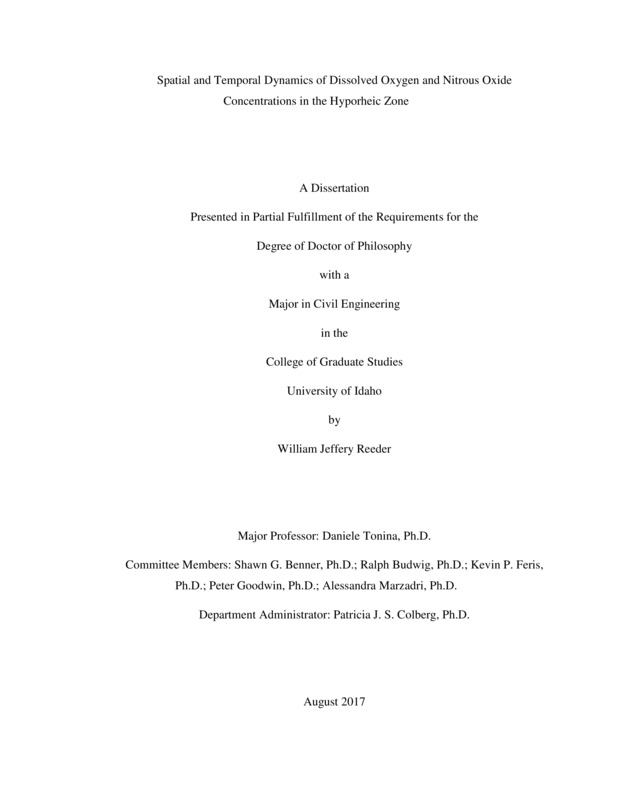Spatial and Temporal Dynamics of Dissolved Oxygen and Nitrous Oxide Concentrations in the Hyporheic Zone
Reeder, William Jeffery. (2017-08). Spatial and Temporal Dynamics of Dissolved Oxygen and Nitrous Oxide Concentrations in the Hyporheic Zone. Theses and Dissertations Collection, University of Idaho Library Digital Collections. https://www.lib.uidaho.edu/digital/etd/items/reeder_idaho_0089e_11221.html
- Title:
- Spatial and Temporal Dynamics of Dissolved Oxygen and Nitrous Oxide Concentrations in the Hyporheic Zone
- Author:
- Reeder, William Jeffery
- ORCID:
- 0000-0001-7558-6497
- Date:
- 2017-08
- Embargo Remove Date:
- 2018-02-28
- Keywords:
- dissolved oxygen hydraulics hyporheic flow hyporheic zone nitrous oxide
- Program:
- Civil Engineering
- Subject Category:
- Environmental engineering; Biogeochemistry; Geochemistry
- Abstract:
-
The majority of chemical reactions in rivers and streams occur within the hyporheic zone (HZ), the saturated sediments directly beneath and adjacent to the stream flow. Hyporheic exchange, flow into and out of the hyporheic zone, represents a primary control over those reactions because the flow rate will determine the residence time and amount of chemical constituents in the HZ. Thus, activity within the HZ is of major importance to the biochemical state and habitat quality of riverine systems. Yet, due to the inherent difficulties associated with obtaining non-invasive chemical measurements in the HZ and the complexity of flow in the HZ as well as interactions between hyporheic hydraulics and the biogeochemical processes, a detailed, mechanistic and predictive understanding of the biogeochemical activity in the HZ has not been developed. To date, the details and complexities of reactive solute transport in the HZ have been described mainly through numerical simulations.
Previous research has demonstrated that an estimated 10% of nitrous oxide (N2O), a potent greenhouse gas, which is released to the atmosphere, comes from rivers and streams. The controls over these emissions are not well understood and a fine-scale predictive model has not been developed. This research focuses on two primary aspects of chemical activity in the HZ, both of which are key elements of the processes that lead to N2O emissions; the metabolic consumption of dissolved oxygen (DO) and the microbially mediate denitrification reaction sequence.
To overcome the difficulties associated with obtaining non-invasive DO measurements in the HZ we developed a new multi-point, in situ, multiplexed fiber optic measurement system. With this system, we were able to profile DO concentrations in the HZ at spatial and temporal resolutions that had not been previously achieved. These high-density measurements allowed us to uncover a significant shortcoming in the current conceptualization of reactive solute transport in the HZ. Previous studies of microbial activity in the HZ have treated the metabolic DO consumption rate (KDO) as a fixed and homogeneous property of the hyporheic environment that is primarily controlled by the availability of labile organic carbon. Our findings demonstrate that aerobic respiration rates are substantially controlled by stream hydraulics. KDO is a distributed property whose values are log-normally distributed and can vary by an order of magnitude across the span of a single bedform. These studies have also perceived the HZ as temporally steady state. This perspective yields a static view of the biogeochemical activity and redox state of the HZ and fails to capture the temporal dynamics of a changeable system. Our results demonstrate that for a system in which nutrient replenishment is largely episodic, for instance annual leaf fall, DO concentration profiles and DO consumption rates will vary with time.
The denitrification reaction sequence that is the direct source for N2O emissions is a kinetic process that takes a period of time to proceed from beginning to end. The time it takes for a parcel of water to travel along a flowline is termed residence time (τ). However, because of the variable dynamics of reactive process in the HZ, residence time, by itself, is not an adequate predictor of N2O emissions. We present a predictive model based on a Damköhler-type transform (τ̃) of the residence times (τ) along a flowline multiplied by the dissolved oxygen consumption rate. This model can identify which bedforms have the potential to produce and emit N2O as well as the portion and location from which those emissions may occur. Our results indicate that that flowlines that that have τ̃up, the τ̃ value at which a flowline exits back into the surface water, between 0.54 and 4.4 are likely to produce and emit N2O. N2O production peaks approximately at τ̃ = 1.8 along a flow line.
- Description:
- doctoral, Ph.D., Civil Engineering -- University of Idaho - College of Graduate Studies, 2017-08
- Major Professor:
- Tonina, Daniele
- Committee:
- Benner, Shawn G; Budwig, Ralph; Feris, Kevin P; Goodwin, Peter; Marzadri, Alessandra
- Defense Date:
- 2017-08
- Identifier:
- Reeder_idaho_0089E_11221
- Type:
- Text
- Format Original:
- Format:
- application/pdf
- Rights:
- In Copyright - Educational Use Permitted. For more information, please contact University of Idaho Library Special Collections and Archives Department at libspec@uidaho.edu.
- Standardized Rights:
- http://rightsstatements.org/vocab/InC-EDU/1.0/

